“Never had the Cairngorms had greater appeal than this farewell journey of mine…”
Tommy Weir, Glasgow
1945
Journeys
At EYA, August has brought a focus on journeys for its monthly theme. The summer months bring drier conditions and the perfect opportunity for outdoor exploration of places such as the Cairngorms. This month the Aberdeen University Collections have offered an insight into their records on the Cairngorm Club.
The Shelter Stone Visitors’ Book
The Cairngorm Club was formed in 1887. Members installed a visitors’ book at the Shelter Stone 100 years ago, in the Summer of 1924. The purpose: “to obtain a record of those who visited this spot” (Duncan, 1926). There was no prescribed format for completion, just some bound blank pages packed inside a watertight tin, sitting tight on a “conspicuous ledge” (Duncan, 1926).
What emerged was fascinating. Hundreds of entries, across multiple decades, fill the pages of seventeen volumes. The weather, the routes, and current affairs are interspersed with poetic musings and quirky illustrations inspired by the journey and the majesty of the surroundings.
The visitors’ books capture the experiences of novices and veterans alike, groups, and solo adventurers. Entries are signed with addresses in Scotland and beyond; Wales, England, America, Poland, India, Norway and South Africa.

Cairngorms Shelter Stone Visitors’ Book 1939-1944
Build up to War
In the Summer of 1939, the familiar commentary of the previous volumes persists. Entries centre around the different approaches groups had taken on their ascent of th Cairngorms. The good, the bad, the ugly weather, and the names of those brave enough to take a dip in the beautiful Loch A’an are mentioned. Cheerful sketches pepper the pages; a portrait of the Shelter Stone’s resident rodent, and friends ascending the mountainous terrain in full sunshine.

“War now started…”
In the next volume, the tone changes. On the opening page, an entry from 30th August 1939 reads; “As we gaze down Loch A’an there is a great calm, only the sound of running water. What a comparison to the madness of a great fear in the hearts of the so-called civilised world…have the Hell Hounds of War been let loose?…”.
The next entry, signed by two walkers, is dated 5th September 1939; “War now started. We have got our first “leave” and are bound for a Flying Training School at the end of the week. A grand day here. Off to Cairngorm.”
Presumably bound for service in the Royal Air Force, the two friends have embarked on a journey to Cairngorms, before beginning another one into the perils of war. There are others in the same position, and entries of a similar nature follow.
May 21st: Peter McCallum writes that he is visiting for the first time. He will be 20 in June and thought he would “like to see it before I’m called up to fight”.
A week later, Tommy Weir from Glasgow spends the night: “Never had the Cairngorms had greater appeal than this farewell journey of mine. Rain and sun in the right proportions and grand mist effects on the tops. Still another days freedom before the army calls.”
James Lumsden stops by on 25th June 1941, “spending last few days as a civilian here in Cairngorms. On Saturday I begin my career as a pilot…” The comments are candid and to the point. These are young men making the most of their freedom in the mountains, not knowing when they might be back again.
“If you cannot find chocolate…”
In September 1941, WT Chambers arrives. A keen photographer, Chambers discusses at length the mechanics and complexities of photography. His ruminations turn to “my closest fellow lover of the hills, now a wireless operator – air gunner. Many weekends have we tramped Derbyshire together…my only wish is that he were here now, but knowing that cannot be so, may he, god willing, survive the fortunes of war and some day accompany me to these hills.”
The following day, Chambers advises visitors of a recipe, for something that will “go down well in the hills” if chocolate cannot be sourced. It involved a mixture of margarine, sugar and cocoa, blended into a somewhat gritty creation!

Sanctuary at Shelter Stone
In the war years, the Shelter Stone became more than just a safe haven away from the changeable and tumultuous weather conditions of the Cairngorms. The Shelter Stone also offered visitors a place of calm, eroded by the hardships of war.
On the 4th May 1940 Donald McIntyre from Edinburgh writes “Evacuated to Grantown. (16). Alone. 1st time. Super day and grand mountains.” It is another candid and brief snapshot, which shows the impact of war on communities. Numerous battalions also made the most of the hospitality of the Shelter Stone.
On the 31st August 1941: The 8th Battalion Gordon Highlanders arrived at 8.30pm carrying arms and ammunition, the note states that the pack load per person was 100lbs. Between the 12th and 17th June 1943 ‘E-Troop’ pass through, part of the No. 4 Commandos, their signatures sprawling 7 pages.

Legacy
These Cairngorms visitors’ books have left a unique legacy. They are an account of the life and times of transient guests. Explorers of an ancient landscape, a wild frontier away from urban industry and a place of peace in the atrocities of war. For some of the visitors to Shelter Stone, their journeys were just beginning.
They were young. With the threat of war, expectation and the unknown weighing heavy on their shoulders, it is fitting that some of these young men chose to spend their freedom in the mountains before going to fight. Their entries in the visitors’ book are a reminder of the journeys they made before they left for war; their fleeting footprints over peaks, and in corries, now lost to nature and time.
Written by Kat Broomfield, Archives Assistant
Edited by Anya Hopkins, EYA Blog Coordinator
Sources supplied by University of Aberdeen Collections, licensed under CC By 4.0.
Further Information and References
- https://www.cairngormclub.org.uk/ (The Cairngorm Club website)
- The Cairngorm Club Journal 064, 1926. Duncan, James L. (1926). The Shelter Stone Visitor’s Book. Cairngorm Club Journal, no.64, p.212-213.
- The Cairngorm Club Journal 069, 1930. Duncan, James L. (1930). Visitor’s Book at the Shelter Stone. Cairngorm Club Journal, no.69, p.117-121.
- The Cairngorm Club Journal 108, 2007. Adams, J. (2007). The Shelter Stone Revisited. Cairngorm Club Journal, no. 108, p.207-210.
- Murray, S. (1987). The Cairngorm Club 1887-1987. The Cairngorm Club. Aberdeen.
- MS 3405/3/1/5-7. The Cairngorm Club. Shelter Stone Visitors Books. 1937-1948. Aberdeen University Collections.
- University Collections | The University of Aberdeen (abdn.ac.uk) (Aberdeen University Collections homepage)



